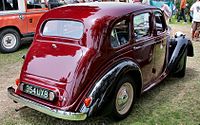
Jaguar is the sports car and luxury vehicle brand of Jaguar Land Rover, a British multinational car manufacturer with its headquarters in Whitley, Coventry, England. Jaguar Cars was the company that was responsible for the production of Jaguar cars until its operations were fully merged with those of Land Rover to form Jaguar Land Rover on 1 January 2013.

The Ford Anglia is a small family car that was designed and manufactured by Ford UK. It is related to the Ford Prefect and the later Ford Popular. The Anglia name was applied to various models between 1939 and 1967. In total, 1,594,486 Anglias were produced. It was replaced by the Ford Escort.

The Daimler Company Limited, before 1910 known as the Daimler Motor Company Limited, was an independent British motor vehicle manufacturer founded in London by H. J. Lawson in 1896, which set up its manufacturing base in Coventry. The company bought the right to the use of the Daimler name simultaneously from Gottlieb Daimler and Daimler-Motoren-Gesellschaft of Cannstatt, Germany. After early financial difficulty and a reorganisation of the company in 1904, the Daimler Motor Company was purchased by Birmingham Small Arms Company (BSA) in 1910, which also made cars under its own name before the Second World War. In 1933, BSA bought the Lanchester Motor Company and made it a subsidiary of the Daimler Company.

The Jaguar XJ is a series of mid-size/full-size luxury cars produced by British automobile manufacturer Jaguar Cars from 1968 to 2019. It was produced across four basic platform generations with various updated derivatives of each. From 1970, it was Jaguar's flagship four-door model. The original model was the last Jaguar saloon to have been designed under the leadership of Sir William Lyons, the company's founder, and the model has been featured in countless media and high-profile appearances.

Lea-Francis was a British motor manufacturing company that began by building bicycles.
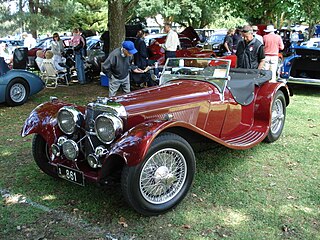
The SS Jaguar 100 is a British 2-seat sports car built between 1936 and 1939 by SS Cars Ltd of Coventry, England. The manufacturer's name 'SS Cars' used from 1934 maintained a link to the previous owner, Swallow Sidecar, founded in 1922 by Walmsley and Lyons to build motorcycle sidecars. In March 1945 the S. S. Cars shareholders agreed to change the name to Jaguar Cars Limited.
The Lanchester Motor Company Limited was a British car manufacturer in active trade between 1899 and 1955. Though the Lanchester Motor Company Limited is still registered as an active company and accounts are filed each year, the marque has been dormant since. As of 2014 it is marked as "non-trading".

The Riley RM is a series of executive cars and compact executive cars that were made by Riley Motors from 1945 until 1955. They were the last models developed independently by Riley before its parent company, Nuffield, merged with Austin to form BMC. The RM series was produced in Coventry until 1949, when production moved to the MG works at Abingdon. Until 1952, models were marketed as the Riley 1½ Litre and the Riley 2½ Litre. the term RM has been used retrospectively to encompass models produced before 1952.

Morris Oxford is a series of motor car models produced by Morris of the United Kingdom, from the 1913 'bullnose' Oxford to the Farina Oxfords V and VI.

The Austin 7 is an economy car that was produced from 1922 until 1939 in the United Kingdom by Austin. It was nicknamed the "Baby Austin" and was at that time one of the most popular cars produced for the British market and sold well abroad. Its effect on the British market was similar to that of the Model T Ford in the US, replacing most other British economy cars and cyclecars of the early 1920s. It was also licensed and copied by companies all over the world. The first BMW car, the BMW Dixi, was a licensed Austin 7. In France they were made and sold as Rosengarts, and in the United States they were built by the American Austin Car Company. In Japan, Nissan also used the 7 design as the basis for their first cars, although not under licence. This eventually led to a 1952 agreement for Nissan to build and sell Austins in Japan under the Austin name.
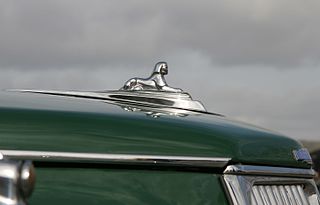
The Armstrong Siddeley Sapphire is a large automobile which was produced by the British company, Armstrong Siddeley Motors Limited, from 1952 to 1960.
SS Cars was a British manufacturer of sports saloon cars from 1934 until wartime 1940, and from March 1935 of a limited number of open 2-seater sports cars. From September 1935, their new models displayed a new name: SS Jaguar. By then, its business, which was founded in 1922, was run by and largely owned by William Lyons. Lyons had been partner with 1922 co-founder William Walmsley until Walmsley sold his shareholding in January 1935.
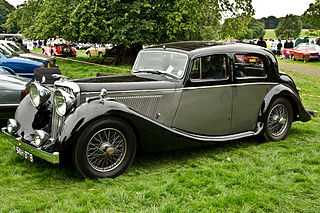
The Jaguar Mark IV is a range of automobiles built by Jaguar Cars from 1945 to 1949. The cars were marketed as the Jaguar 1½ litre, Jaguar 2½ litre and Jaguar 3½ litre with the Mark IV name later applied in retrospect to separate this model from the succeeding Mark V range.

The Daimler Conquest is an automobile which was produced by The Daimler Company Limited in the United Kingdom from 1953 to 1958. Based on the Lanchester Fourteen, the Conquest replaced the Daimler Consort. Sales were affected by increasing prices and by the fuel shortage caused by the Suez Crisis, and production ended by January 1958, before a replacement model was in production.
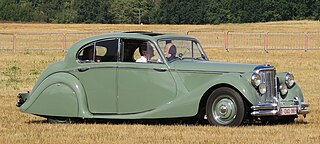
The Jaguar Mark V is a luxury automobile built by Jaguar Cars Ltd of Coventry in England from 1948 to 1951. It was available as a four-door Saloon (sedan) and a two-door convertible known as the Drop Head Coupé, both versions seating five adults. It was the first Jaguar with independent front suspension, first with hydraulic brakes, first with spats, first specifically designed to be produced in both Right and Left Hand Drive configurations, first with disc centre wheels, first with smaller wider 16" balloon tyres, first to be offered with sealed headlamps and flashing turn signals for the important American market, and the last model to use the pushrod engines.

The Standard Eight is a small car produced by the British Standard Motor Company from 1938 to 1959.
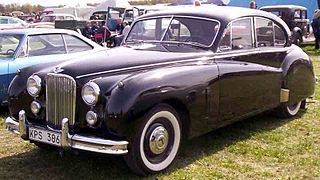
The Jaguar Mark VII is a four-door luxury car produced by Jaguar Cars of Coventry from 1950 to 1956. Launched at the 1950 British International Motor Show as the successor to the Jaguar Mark V, it was called the Mark VII because there was already a Bentley Mark VI on the market. A version of the Jaguar Mark V with the XK engine had been designated as the Mark VI, but it is thought that only two were built.

The Hillman Fourteen is a medium-sized 4-cylinder car announced by Hillman's managing director Spencer Wilks, a son-in-law of William Hillman, at the end of September 1925. This new Fourteen substantially increased Hillman's market share and remained on sale into 1931. During this time it was the main product of the company.

The Standard Flying Fourteen is an automobile which was produced by the British Standard Motor Company from 1936 to 1940 and announced in October 1936. The other Flying Standard models had been announced twelve months earlier. A standard is a flag and the reference to flying standards is to flying flags as well as to the advertised abilities of the cars.

The Jaguar XF (X260) is an executive/mid-size luxury sports saloon manufactured and marketed by the Jaguar Cars brand of Jaguar Land Rover from 2015 to 2024, in sedan/saloon and station wagon/estate body styles. Following the first generation steel-bodied X250 XF introduced in 2007, the second-generation XF sedan/saloon debuted at the 2015 New York International Auto Show, noted for its aluminium bodywork.


